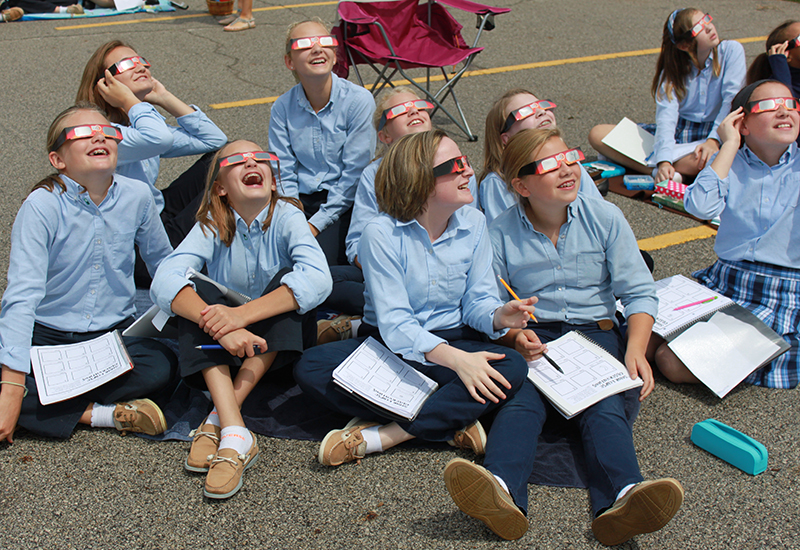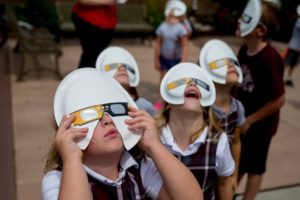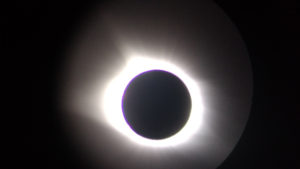Budding scientists at St. Philomena, Peoria, track eclipse, link it with faith

Armed with their observation sheets to collect data, junior high students at St. Philomena School, Peoria, tracked the solar eclipse from beginning to end. (Provided photo)
Viewing a solar eclipse is a once-in-a-lifetime opportunity and the budding scientists at St. Philomena School in Peoria were determined not to waste it. That’s good news for everyone, especially the scientists at NASA.
Their observations will be sent to the space agency and studied along with findings from people across the United States, according to Sue Tony, a junior high science teacher at St. Philomena who knows people at NASA and has been involved in previous experiments.

Students in Catholic schools around the diocese ventured outside to view the partial solar eclipse with protective glasses. At St. Jude School in Peoria, those were secured with paper plates. Here Aislin Magner, Emersyn Andrews, and Samantha Ryan take in the celestial event. (Provided photo/Daryl Wilson)
“They send out a lot of things for teachers so I still get all that information,” she told The Catholic Post. “They have educational experts and they kind of connect with the schools and reach out. They ask for student involvement.”
In this case, the junior high teachers at St. Philomena decided to make the eclipse the focus for the first week of school since it was something that would be exciting for the students. The curriculum they designed had the students studying and making models of lunar, solar and annular eclipses and doing simulations.
COLLECTING DATA
When Aug. 21 arrived, they were armed with data sheets to collect information about the temperature, cloud patterns, wind direction and animal behavior before, during and after the solar eclipse. Even though central Illinois was not in the path of totality, the young scientists were able to observe 93 percent coverage of the sun.
“They noticed a significant drop in temperature before and after, so that was kind of cool, Tony said. While local meteorologists didn’t report much of a change, the students found that the temperature on the playground at St. Philomena went from about 87 degrees to 75 degrees, and noted that the wind picked up.
While they could hear the insects and birds before the eclipse, they didn’t hear those sounds anymore after it started, Tony said.
“It was almost like they were getting ready for the night,” she explained. “They were getting ready to roost; they were getting ready to settle. . . . It got quieter outside.”
They prayed the rosary outside as a school community and were invited to consider Venerable Archbishop Fulton Sheen’s words about viewing Jesus as the sun and Mary as the moon.
Using protective glasses, the students also sketched the changes in the sun as the eclipse progressed.
Tony said the students will gather in groups to discuss their data and then compile it. Then their outcomes will be sent to NASA for further study and comparison.
LESSONS LEARNED
As they wrap up the unit, the students will be asked to reflect on their experience and share what it meant to them.
“It’s pretty awesome,” Tony said. “Not many people have a chance to see that in a lifetime.”

The total solar eclipse is seen from Chester on the afternoon of Aug. 21. While central Illinois was not in the path for a total eclipse, there was still 93 percent coverage of the sun. (CNS/Brandon A. Evans)
It will also provide a valuable lesson about why scientists take these kinds of opportunities to look at natural events and collect as much data as they can, she said, adding that the need to measure things carefully and double check that information was another lesson learned.
Because St. Philomena is a Catholic school, junior high religion teacher Danielle VanMeenen also helped students make a faith connection.
They prayed the rosary outside as a school community and were invited to consider Venerable Archbishop Fulton Sheen’s words about viewing Jesus as the sun and Mary as the moon. While both are brilliant, without the sun (Jesus), the moon (Mary) would not shine.
Despite the serious lessons they learned, the students still had plenty of fun, Tony told The Post.
“They thought it was great,” she said. “We had a countdown.”





